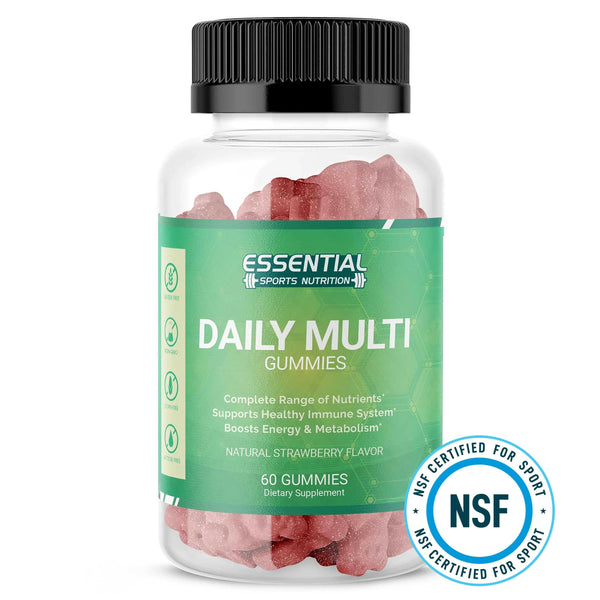The Science Behind a Balanced Diet Macronutrients and Micronutrients
Embarking on a journey to nourish your body and mind, you've likely encountered the term balanced diet. Central to the discipline of nutritional science, understanding the interplay between macronutrients and micronutrients is pivotal in cultivating healthy eating habits and achieving the zest of well-being. This comprehensive dive into dietary essentials is not solely about the avoidance of processed indulgences but is a celebration of optimal nutrition sources that fortify your health from the cellular level onwards.
Healthy eating isn't a trendy diet or restrictive regimen; rather, it's a sustainable approach filled with colorful plates and diverse nutrients. As you navigate various food landscapes, this exploration will enlighten you on how to fuel your body consummately, so let's unveil how to blend these vital nutrients for your vibrant lifestyle.
Key Takeaways
- Unlock the mysteries of macronutrients and their roles as your powerhouse of energy.
- Discover how a rainbow of micronutrients can shield your health and stave off disease.
- Learn the significance of blending a variety of nutritional science-approved food choices into your meals.
- Identify optimal nutrition sources to elevate the quality of your balanced diet.
- Adopt healthy eating habits that emphasize both satisfaction and sustenance.
Introduction to Balanced Nutrition

Welcome to the core of a sound lifestyle: balanced nutrition. Understanding the role a nutrient-rich diet plays in your overall health is critical, and it's about more than simply filling your plate; it's about filling your body with the right kind of energy. Let's explore what that means for you.
The Importance of Nutrient-Dense Foods
In the pursuit of balanced nutrition, what sits atop your fork is as important as how much you're eating. A nutrient-rich diet is about selecting foods that are high in essential vitamins and minerals and other nutrients while being relatively low in calories. This way, each bite packs a punch in terms of fueling your body's needs.
For example, leafy greens, like spinach and kale, are low in calories yet overflowing with vitamins A, C, K, and iron. They're the superheroes of the food world, enabling you to ingest a dense collection of nutrients without overdoing it on your daily calorie limits. Now consider the diversity needed across all food groups breakdown, and it's clear a thoughtful approach to your meals can lead to an overall healthier you.
What "Healthy Eating" Really Means
When we talk about 'healthy eating,' we're referring to more than just a passing fad or a quick-fix diet. It's about sustaining a lifestyle that embraces a wide range of food categories, all with the goal of optimizing your intake of essential vitamins and minerals.
A balanced nutrition isn't just about what you're eating, but how those foods work together to nourish your body. A rainbow of vegetables, a variety of lean proteins, whole grains, nuts, and seeds deliver a symphony of nutrients that keep your system running smoothly.
Mixing these nutrient powerhouses can help defend against modern health threats such as type 2 diabetes, cardiovascular disease, and obesity. It's the mosaic of nutrients within these foods that bolsters not just your physical health, but your psychological well-being too. So, let's transform that understanding into action with a food groups breakdown.
| Food Group | Essential Nutrients | Examples |
|---|---|---|
| Fruits | Vitamins A and C, Potassium, Dietary Fiber | Apples, Bananas, Berries |
| Vegetables | Vitamins A, C, K, Iron, Magnesium | Spinach, Carrots, Broccoli |
| Grains | B Vitamins, Iron, Dietary Fiber | Whole Wheat, Brown Rice, Quinoa |
| Proteins | Protein, B Vitamins, Iron | Chicken, Fish, Legumes |
| Dairy | Calcium, Vitamin D, Protein | Milk, Yogurt, Cheese |
| Fats | Essential Fatty Acids, Vitamin E | Avocado, Nuts, Olive Oil |
Remember, your journey to balanced nutrition isn't one-size-fits-all. It's about finding what fits your lifestyle and fulfills your body's specific needs. As you venture into this world of colors, varieties, and flavors, you're equipping yourself with the knowledge to make choices that benefit your health today and for years to come.
Why Macronutrients and Micronutrients Matter

Understanding the impact of macronutrients and micronutrients on your body is fundamental to optimizing your health. An appreciation for how these nutrients serve as your body's primary energy source and underpin your health and disease prevention efforts is essential. Let's delve deeper into these nutrients, starting with macronutrients.
Defining Macronutrients: Your Body's Energy Source
When considering what your body needs for energy, macronutrients are the cornerstone of your dietary intake. These include carbohydrates, proteins, and fats. Counting macros, a popular dietary approach, involves tracking these nutrients to ensure you're getting the right balance to fuel your energy needs. Each plays a critical role in your body's growth and development, and adhering to dietary guidelines ensures you're getting what's required for sustenance and well-being.
Understanding Micronutrients: Vital for Health and Disease Prevention
Micronutrients, though needed in smaller amounts, are equally important for maintaining overall health. They are instrumental in processes ranging from bone formation to immune system function. Ensuring a diet diverse in vitamins and minerals helps ward off diseases and nourishes your body's complex systems.
Here's a simplified view of how these nutrients contribute to your daily dietary needs:
| Nutrient Type | Role in the Body | Examples | Daily Recommended Intake |
|---|---|---|---|
| Carbohydrates | Primary energy source for daily activities | Whole grains, fruits, vegetables | 45-65% of total calories |
| Proteins | Repair and build tissues; support immune function | Lean meats, dairy, legumes | 10-35% of total calories |
| Fats | Energy storage, cell structure, nutrient absorption | Avocado, nuts, olive oil | 20-35% of total calories |
| Vitamins & Minerals | Critical for metabolic processes, disease prevention, and growth | Leafy greens, fruits, dairy | Varies by specific nutrient |
By paying attention to the balance of macronutrients and micronutrients, you're not just eating; you're nourishing your body. Make each meal an opportunity for health and vitality by choosing foods that align with these comprehensive dietary guidelines.
The Energy Providers: Carbohydrates, Fats, and Proteins
Understanding how the body derives energy from food is fundamental to composing a health-conscious diet. By acquainting yourself with the nutritional roles of carbohydrates, fats, and proteins, you can tailor your consumption to optimize both metabolic health and physical performance.
Carbohydrates are often referred to as the body's primary source of energy. They break down into glucose, which fuels your daily activities and powers your brain. Contrary to popular belief, carbs are not the enemy but an essential energy provider, especially for those with an active lifestyle.
- Simple Carbohydrates: Found in fruits, milk, and sweeteners, they provide instant energy.
- Complex Carbohydrates: Present in whole grains and legumes, they offer sustained energy release.
Next up are fats, which pack a high-energy punch as they contain more than double the calories per gram than carbohydrates and proteins. Despite their bad reputation, fats are indispensable for long-term energy, cushioning organs, and aiding in the absorption of fat-soluble vitamins.
- Saturated Fats: Typically from animal sources, intake should be moderated.
- Unsaturated Fats: Found in plants and fish, they are beneficial for heart health.
Proteins, made up of amino acids, are the cornerstone of cellular repair and body growth. Whether you're healing from an injury or building muscle mass, proteins play a crucial role in your body's recuperative processes.
Did you know? The human body requires twenty different amino acids, nine of which must be obtained through diet, as our bodies can't produce them.
| Macronutrient | Calories per Gram | Primary Function |
|---|---|---|
| Carbohydrates | 4 | Immediate energy source |
| Fats | 9 | Long-term energy reserve |
| Proteins | 4 | Cell repair and growth |
In conclusion, a balanced intake of carbohydrates, fats, and proteins is vital for a diet that delivers ample energy, keeps your metabolism humming, and supports continuous growth and repair. Remember, moderation and variety in your nutrient intake will pave the way for a healthier you.
Breaking Down Carbohydrates: Simple vs. Complex

As your main food source for fuel, carbohydrates are essential for keeping you energized throughout the day. These forms of calories come in two primary types, each playing a unique role in your diet and impacting your health in different ways.
The Role of Carbohydrates in Energy Production
Carbohydrates are your body's go-to source for quick energy. They break down into glucose, feeding your cells and keeping your power reserves stocked. Not all carbohydrates are created equal, though—while some give you a swift energy boost, others are instrumental in providing sustained energy that lasts throughout the day.
Identifying Healthy Sources of Carbohydrates
To optimize health, it's wise to focus on complex carbohydrates. These include nutrient-packed whole grains, such as oats and quinoa, as well as starchy vegetables like sweet potatoes. Unlike their simple counterparts, these complex carbs provide a slow release of energy, helping to regulate blood sugar levels and keep you feeling fuller for longer.
- Sweet potatoes: A fiber-rich, starchy vegetable that's full of vitamins and minerals.
- Whole grains: Integral for a hearty diet, they are linked to various health benefits, including reduced risk of heart disease.
- Legumes: Not only high in protein, but their complex carbs are perfect for a lasting energy supply.
Choosing the right type of carbohydrates as part of a balanced diet is crucial. Replace refined sugars and grains with whole, unprocessed carbohydrates to ensure you're leveraging the best form of calories for your body's needs.
Proteins: The Building Blocks of Growth and Development
When you think about proteins, imagine them as the scaffolding of life's architecture. These essential components are the workload heroes behind your muscle mass, catalyzing every major functional process from digestion to repairing tissues. Your body requires proteins, not just to bulk up, but to sustain almost every biological operation. Understanding what sources of protein are most beneficial, as well as the importance of dietary protein intake and amino acids, is crucial for anyone aiming to maintain a healthy and robust physique.
It's no secret that proteins are a diverse bunch, with amino acids as their building blocks, each kind plays a specific role in keeping your body functional and fit. Think of amino acids as the alphabet of proteins; combining them in different ways creates the vast variety of proteins necessary for your well-being.
| Complete Proteins (Contains all essential amino acids) | Incomplete Proteins (Lacks one or more essential amino acids) |
|---|---|
| Meat | Nuts |
| Poultry | Seeds |
| Fish | Legumes |
| Eggs | Whole grains |
| Dairy Products | Vegetables |
One of the vital roles of protein is building and preserving muscle mass. Not only do bodybuilders need it, but so does every person who wishes to keep their muscles strong and functionally efficient. This is especially true as we age, with protein playing a pivotal role in maintaining muscle strength and mobility.
Whether you're a meat-lover or plant-preferring individual, your diet can be rich in high-quality protein. Animal products are known to be complete proteins, offering all the amino acids your body can't produce. But don't fret if you're vegan or vegetarian; by combining various plant-based proteins like beans with rice or hummus with whole grain pita, you can acquire all those essential amino acids.
Keep in mind that dietary protein intake should be balanced and not excessive. It's not just about quantity; the quality of the protein is just as important. Listen to your body's needs and ensure a moderate, varied intake for the best results in health and muscle maintenance.
Fats: Understanding the Good, the Bad, and the Essential

It's time to challenge the stigma attached to fats and comprehend their intrinsic role in a nourishing diet. Not all fats are created equal, and it's imperative for you to discern between those that bolster your health and those that pose risks. By doing so, you embark on a journey to a more balanced and health-conscious way of eating.
The Unfair Demonization of Fats: A New Perspective
Fats have long endured a reputation as dietary villains, but the narrative is changing. Not only do fats provide a concentrated source of energy, they're also pivotal for the absorption of fat-soluble vitamins and in maintaining our body's core temperature. Let's redefine our understanding, paving the way for a new era of embracing healthy fats.
How the Right Fats Contribute to a Balanced Diet
The inclusion of healthy fats in your diet is no longer a suggestion—it's an essential dietary guideline. Unsaturated fats—the good guys—support brain function, aid in nutrient absorption, and can even help reduce the cardiovascular disease risk. These wonderous fatty acids are key to a flourishing health profile and are found abundantly in nature's pantry.
| Fat Type | Food Source | Health Impact |
|---|---|---|
| Monounsaturated Fats | Olives, Avocados, Nuts | May decrease bad cholesterol levels |
| Polyunsaturated Fats | Flaxseeds, Walnuts, Fatty Fish | Essential fatty acids; promote heart health |
| Saturated Fats | Red Meat, Butter, Cheese | Can increase cardiovascular disease risk if consumed excessively |
| Trans Fats | Processed Foods, Margarines | Contribute to heart disease; should be avoided |
Indeed, the world of fats is complex, but understanding the contrasts between saturated fat and unsaturated fats can revolutionize your eating habits. Migrate towards a heart-healthy approach by choosing oils rich in unsaturated fats, such as olive or canola, and integrating fatty fish into your diet. The payoff is a wealth of health benefits that collectively stave off chronic diseases and elevate your overall well-being.
The Science Behind a Balanced Diet: Macronutrients and Micronutrients

Underpinning a balanced diet is a complex interplay between macronutrients and micronutrients, essential for maintaining optimal health. The World Health Organization offers guidance grounded in decades of research, advocating for a structured approach to nutrient intake. These recommendations ensure every morsel of your food intake contributes to your overall well-being.
At the heart of a diet based on science lies the balance and diversity of macronutrients—carbohydrates, proteins, and fats—that power various body functions. Carbohydrates are the body's main energy source, proteins are the building blocks for growth and repair, and fats support cell health. Alongside these, micronutrients play crucial but often less heralded roles in disease prevention and health efficacy.
- Whole Foods: Prioritize fruits, vegetables, and whole grains to naturally increase your nutrient intake.
- Varied Choices: Incorporate a variety of protein sources, such as lean meats, dairy, and legumes, to cover your amino acids needs.
- Moderation is Key: Enjoy fats in moderation, focusing on healthy unsaturated fats found in nuts, seeds, and fish.
Adhering to these simple tenets of a balanced diet, as endorsed by the World Health Organization, sets the stage for a lifetime of health. Making informed choices about food intake isn't just about meeting the baseline nutritional requirements—it's also about optimizing your body's performance and hedging against the development of chronic diseases. Adopt a thoughtful approach to how you nourish your body; it's one of the most significant investments you can make in your long-term health.
Vitamins and Minerals: A Guide to Your Body’s Micro-Needs

While you focus on macronutrients to satisfy your hunger and energy needs, it's the vitamins and minerals that silently play a crucial role in maintaining your health. These micronutrients are the unsung heroes that support everything from your bone strength to your immune system. Even though they are needed in smaller quantities, a deficiency in these vital nutrients can have significant implications on your body's functionality.
The Spectrum of Vitamins: Water-Soluble vs. Fat-Soluble
Understanding the difference between water-soluble and fat-soluble vitamins is key to managing your health. Your body quickly uses water-soluble vitamins, such as vitamin C and the B-complex. It eliminates the surplus through urine, necessitating frequent replenishment through foods like citrus fruits, leafy greens, and whole grains. Conversely, fat-soluble vitamins such as A, D, E, and K, found in items like eggs, dairy, and leafy vegetables, are stored within your liver and fat tissues, being called upon as required. This strategic storage allows your body to tap into these reserves when your dietary intake may be lacking.
Minerals: The Often Overlooked Dietary Essentials
Minerals like calcium and magnesium warrant just as much attention as vitamins and other nutrients in your diet. Critical for bone health, nerve function, and muscle contraction, these minerals are found in a variety of sources such as dairy products, nuts, and legumes. It's important to integrate a diverse range of colors and types of foods into your meals to ensure you're getting the full spectrum of vitamins and minerals. After all, your body relies on this intricate balance of micronutrients to maintain optimal health and facilitate countless biochemical processes.
Macronutrients and Micronutrients FAQs
Q: What are macronutrients and micronutrients?
A: Macronutrients are nutrients required by the body in large amounts, such as proteins, fats, and carbohydrates, while micronutrients are nutrients needed in smaller amounts, including vitamins and minerals.
Q: Why are macronutrients and micronutrients important in a balanced diet?
A: Macronutrients provide us with energy, while micronutrients are necessary for various functions in the body, such as metabolism and immunity.
Q: How do proteins, fats, and carbohydrates contribute to a balanced diet?
A: Proteins are essential for muscle growth and repair, fats provide a source of energy and aid in nutrient absorption, and carbohydrates are the body’s main source of energy.
Q: Can an unbalanced diet affect the intake of macronutrients and micronutrients?
A: Yes, if the diet isn’t balanced, it may lead to deficiencies in certain nutrients, as micronutrients don’t function optimally in isolation.
Q: What is the role of vitamins and minerals in a healthy diet?
A: Vitamins and minerals, known as micronutrients, are needed in small amounts to support various bodily functions and overall health.
Q: How can a dietitian help in ensuring the right balance of macronutrients and micronutrients?
A: Dietitians are trained professionals who can provide personalized advice on dietary choices to ensure a balanced intake of macronutrients and micronutrients.
Q: What are some sources of micronutrients and macronutrients?
A: Micronutrients can be found in a variety of foods, such as green leafy vegetables, fruits, and nuts, while macronutrients are present in foods like protein-rich meats, whole grains, and healthy fats.




























